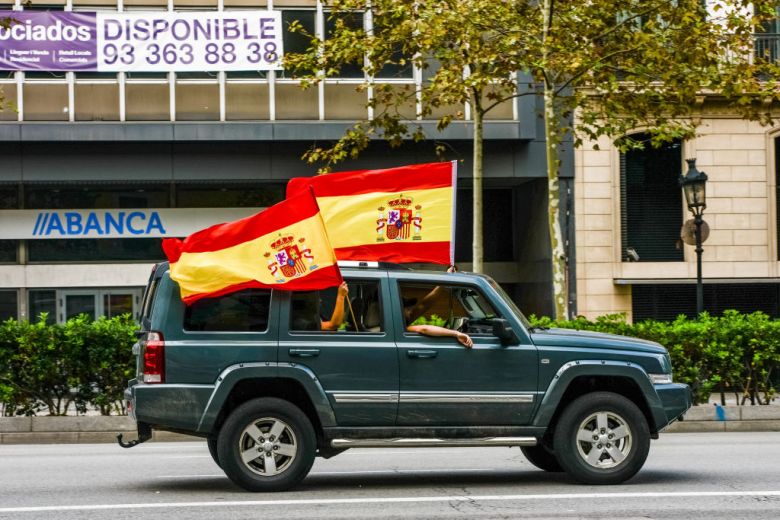Failure to adhere to speed limits in Spain could result in a hefty €600 on-the-spot fine. Your vehicle may also be sized by the police until the fine is paid in full.
To help you stay on the right side of the law, this driving in Europe guide looks at speed limits in Spain, changes to the rules of foreign drivers, and what you’ll need to bring with you – along with some helpful tips that can help make your next trip to Spain an unforgettable experience.
Speed limits in Spain
Spanish speed limits are measured in km/h rather than mph – so make sure you are reading your dashboard correctly.
Your speedo should show both units, with the km/h reading in smaller numbers. If not, it's useful to know that 80km/h is 50mph and 100km/h is 62mph.
| Motorway speed limits | Urban rural road speed limits | ||
|---|---|---|---|
| Cars and motorbikes | 80 km/h - 120 km/h | Cars and motorbikes | 90 km/h |
| Vans and mini-buses | 80 km/h - 100 km/h | Vans and mini-buses | 80 km/h |
| Vehicles with trailers weighing less than 750kg | 80 km/h - 90 km/h | Vehicles with trailers weighing less than 750kg | 70 km/h |
| Vehicles with trailers weighing more than 750kg | 80 km/h | Vehicles with trailers weighing more than 750kg | 60 km/h |
Built-up areas with urban roads in Spain have lower speed limits, which apply to all types of vehicles.
- 20 km/h on roads shared with pedestrians
- 30 km/h for one lane per direction
- 50 km/h on roads with two lanes per direction
Like many countries around the world, the speed limit on motorways in Spain can be changed via smart motorways and variable speed limits. Be aware of the signs and adjust your speed limit accordingly.
Weather conditions, accidents, roadblocks and more can all impact the limits on the motorways.
If you are towing a caravan, then the speed limits are slightly different compared to normal vehicles.
Drivers must adhere to a speed limit of 80km/h on motorways and 70 km/h on single lane carriageways.
Finally, if you are travelling on Spanish motorways – there is a minimum speed limit of 60km/h. This is reduced by 10km/h in difficult driving conditions.

Instant cover available
• 24/7 rescue at the roadside
• Help to get home if your vehicle can't be fixed
• 5 star Defaqto rated cover

Spanish speeding fines
If you are looking to drive on Spanish roads, beware of the current limits.
Otherwise, you could face a heavy fine. However, unlike some countries, if you are caught speeding in Spain, it is unlikely you will get any points on your UK Licence (unless you break a more serious law while behind the wheel).
Fines range from €100 to €600 – and a short summary can be seen below.
| Speed limit | Exceeding by (up to xx km/h) | Fine in € |
|---|---|---|
| 50 km/h | 20 | 100 |
| 30 | 300 | |
| 40 | 400 | |
| 50 | 500 | |
| 50+ | 600 | |
| 80 km/h | 30 | 100 |
| 50 | 300 | |
| 60 | 400 | |
| 70 | 500 | |
| 70+ | 600 | |
| 100 km/h | 30 | 100 |
| 50 | 300 | |
| 60 | 400 | |
| 70 | 500 | |
| 70+ | 600 | |
| 120 km/h | 30 | 100 |
| 50 | 300 | |
| 60 | 400 | |
| 70 | 500 | |
| 70+ | 600 |
Driving laws for British citizens living in Spain
You can use your UK driving licence for up to 6 months after becoming a resident in Spain. If you wish to continue to drive in Spain after six months, you must apply for a Spanish driving licence.
You should apply for a Spanish driving licence before the six month deadlines has passed, otherwise you will not be able to drive in Spain due to your licence not being valid.
You cannot use an International Driving Permit (IDP) instead of a Spanish licence.
Driving in Spain
Before you set off on your Spanish adventure, there are some important things to remember when driving across the country.
In addition to required documents, British motorists in the country are required by law to carry the following items when driving to avoid hefty on-the-spot fines from the police.
In your car, you will need reflective jackets for yourself and all passengers. These might not be mandatory in some places, but you will be fined for walking on the road or hard shoulder if not wearing one if your car does break down.
You will also need a warning triangle and headlamp beam deflectors with you on your journey.
For anyone driving a motorbike or taking a bicycle on the road, crash helmets are compulsory. Motorcycles on the road must have their lights on at all times.
Finally, around 20% of Spanish motorways will have tolls that cost up to €30 – so keep an eye out for the ‘autopistas’ and get in the correct lane.
READ MORE: Get ready for your Spanish road trip
- Speed cameras – how they work
- Speeding fines – how much you have to pay
- How to save fuel – the ultimate guide

Instant cover available
• 24/7 rescue at the roadside
• Help to get home if your vehicle can't be fixed
• 5 Star Defaqto rated cover

Preparing for your trip to Spain
Packing the car for a European road trip is an important step if you are to have an enjoyable holiday.
Whether you are planning to drive from the UK to Spain, or are looking at hiring a car when you are in the country, make sure the vehicle is up to the task for you and your passengers. You could consider taking our car hire excess insurance to cover you for the excess fee that car hire companies can charge you if the hire car is damaged or stolen. If you decide to share a car with multiple drivers, by law you must be insured. RAC Temporary Car Insurance provides cover from a minimum of one hour to a maximum of 30 days.
Before heading off on any long journey it’s always a good idea to carry out some quick checks that you can do on a vehicle to make sure your car is good to go.
Also, before you set off on your journey, make sure you take out European Breakdown Cover. Check out our annual or single trip cover, you can also see how the RAC European Breakdown Cover compares to providers such as the AA and Greenflag.
The driving specifications across Spain and the rest of Europe are different to those in the UK, meaning you need more items in your safety kit than usual.
Grab a European Driving kit to make sure that you have everything you need to comply with the different driving requirements. It also includes items that can ensure your safety in case of an emergency so that you have peace of mind.
Also, make sure you have important documents with you at all times if you are behind the wheel - like your travel insurance.
What documents will you need to drive in Spain?
Now that your car is packed and ready to go, there is one last check you need to make.
In order to drive in Spain, you will need a full, valid UK driving licence, your UK passport, your car insurance certificate, and V5 registration form. The final two will only be needed if you are driving your own vehicle while in the country. You must be over the age of 18 to drive in Spain.
RAC European Breakdown Cover provides a wide range of benefits should you breakdown in Spain to ensure you stay safe.
The RAC also offers travel insurance. Cover will include medical expenses, baggage, personal money, and belongings, among many other benefits.
Finally, the distinguishing mark (or national identifier) displayed on vehicles registered in the United Kingdom that are driven abroad have been changed from GB to UK.
This means that vehicles registered in the UK must display the letters “UK” when driven in Spain.
In Spain, the sticker must be visible no matter what is on your number plate.










